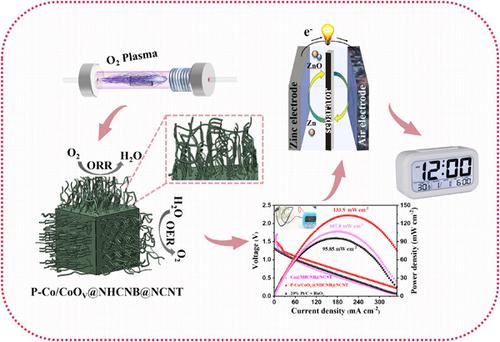当前位置:
X-MOL 学术
›
Carbon Energy
›
论文详情
Our official English website, www.x-mol.net, welcomes your feedback! (Note: you will need to create a separate account there.)
Co/CoO heterojunction rich in oxygen vacancies introduced by O2 plasma embedded in mesoporous walls of carbon nanoboxes covered with carbon nanotubes for rechargeable zinc–air battery
Carbon Energy ( IF 20.5 ) Pub Date : 2024-02-28 , DOI: 10.1002/cey2.457 Leijun Ye 1 , Weiheng Chen 2 , Zhong‐Jie Jiang 3 , Zhongqing Jiang 1
Carbon Energy ( IF 20.5 ) Pub Date : 2024-02-28 , DOI: 10.1002/cey2.457 Leijun Ye 1 , Weiheng Chen 2 , Zhong‐Jie Jiang 3 , Zhongqing Jiang 1
Affiliation

|
Herein, Co/CoO heterojunction nanoparticles (NPs) rich in oxygen vacancies embedded in mesoporous walls of nitrogen-doped hollow carbon nanoboxes coupled with nitrogen-doped carbon nanotubes (P–Co/CoOV@NHCNB@NCNT) are well designed through zeolite-imidazole framework (ZIF-67) carbonization, chemical vapor deposition, and O2 plasma treatment. As a result, the three-dimensional NHCNBs coupled with NCNTs and unique heterojunction with rich oxygen vacancies reduce the charge transport resistance and accelerate the catalytic reaction rate of the P–Co/CoOV@NHCNB@NCNT, and they display exceedingly good electrocatalytic performance for oxygen reduction reaction (ORR, halfwave potential [EORR, 1/2 = 0.855 V vs. reversible hydrogen electrode]) and oxygen evolution reaction (OER, overpotential (ηOER, 10 = 377 mV@10 mA cm−2), which exceeds that of the commercial Pt/C + RuO2 and most of the formerly reported electrocatalysts. Impressively, both the aqueous and flexible foldable all-solid-state rechargeable zinc–air batteries (ZABs) assembled with the P–Co/CoOV@NHCNB@NCNT catalyst reveal a large maximum power density and outstanding long-term cycling stability. First-principles density functional theory calculations show that the formation of heterojunctions and oxygen vacancies enhances conductivity, reduces reaction energy barriers, and accelerates reaction kinetics rates. This work opens up a new avenue for the facile construction of highly active, structurally stable, and cost-effective bifunctional catalysts for ZABs.
中文翻译:

用于可充电锌空气电池的碳纳米管覆盖的碳纳米盒介孔壁中嵌入 O2 等离子体引入的富含氧空位的 Co/CoO 异质结
在此,通过沸石-Co/CoO V @NHCNB@NCNT,精心设计了嵌入氮掺杂空心碳纳米盒介孔壁中的富含氧空位的Co/CoO异质结纳米颗粒(NP)与氮掺杂碳纳米管耦合(P–Co/CoO V @NHCNB@NCNT)。咪唑骨架(ZIF-67)碳化、化学气相沉积和O 2等离子体处理。因此,三维NHCNBs与NCNTs以及具有丰富氧空位的独特异质结的耦合降低了电荷传输阻力,加速了P-Co/CoO V @NHCNB@NCNT的催化反应速率,并表现出了极其良好的电催化性能对于氧还原反应(ORR,半波电位 [ E ORR,1/2 = 0.855 V vs. 可逆氢电极])和析氧反应(OER,过电位(η OER, 10 = 377 mV@10 mA cm −2),这超过了商业 Pt/C + RuO 2和大多数以前报道的电催化剂。令人印象深刻的是,用 P-Co/CoO V组装的水系和柔性可折叠全固态可充电锌空气电池(ZAB)@NHCNB@NCNT催化剂具有较大的最大功率密度和出色的长期循环稳定性,第一性原理密度泛函理论计算表明,异质结和氧空位的形成增强了电导率,降低了反应能垒,加快了反应动力学速率。这项工作为轻松构建高活性、结构稳定且经济高效的 ZAB 双功能催化剂开辟了一条新途径。
更新日期:2024-02-29
中文翻译:

用于可充电锌空气电池的碳纳米管覆盖的碳纳米盒介孔壁中嵌入 O2 等离子体引入的富含氧空位的 Co/CoO 异质结
在此,通过沸石-Co/CoO V @NHCNB@NCNT,精心设计了嵌入氮掺杂空心碳纳米盒介孔壁中的富含氧空位的Co/CoO异质结纳米颗粒(NP)与氮掺杂碳纳米管耦合(P–Co/CoO V @NHCNB@NCNT)。咪唑骨架(ZIF-67)碳化、化学气相沉积和O 2等离子体处理。因此,三维NHCNBs与NCNTs以及具有丰富氧空位的独特异质结的耦合降低了电荷传输阻力,加速了P-Co/CoO V @NHCNB@NCNT的催化反应速率,并表现出了极其良好的电催化性能对于氧还原反应(ORR,半波电位 [ E ORR,1/2 = 0.855 V vs. 可逆氢电极])和析氧反应(OER,过电位(η OER, 10 = 377 mV@10 mA cm −2),这超过了商业 Pt/C + RuO 2和大多数以前报道的电催化剂。令人印象深刻的是,用 P-Co/CoO V组装的水系和柔性可折叠全固态可充电锌空气电池(ZAB)@NHCNB@NCNT催化剂具有较大的最大功率密度和出色的长期循环稳定性,第一性原理密度泛函理论计算表明,异质结和氧空位的形成增强了电导率,降低了反应能垒,加快了反应动力学速率。这项工作为轻松构建高活性、结构稳定且经济高效的 ZAB 双功能催化剂开辟了一条新途径。



























 京公网安备 11010802027423号
京公网安备 11010802027423号